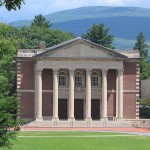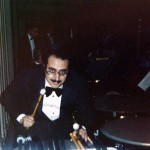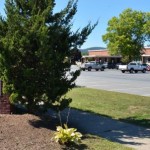My Musical Career | Part Sixteen
The Albany Years | Part Two
In addition to my position as timpanist with the Albany Symphony Orchestra, I was asked by Maestro Hegyi to act in a similar capacity with his other orchestra, The Berkshire Symphony Orchestra. This last named orchestra was the orchestra of Williams College, based in the beautiful New England town of Williamstown, Massachusetts. Williamstown is located about thirty-five miles to the northeast of Albany, and Maestro Hegyi was the head of the string department and conductor of the orchestra at the school, and Williamstown was his home and base of operations. The orchestra was made up of about fifty students from the school and about ten or so talented local musicians, and the maestro invited about ten or so players from the Albany Symphony to round out the complement.
Rehearsals and concerts took place at Chapin Hall, a lovely hall built in 1910, and seating about 1100 people. It would have been the perfect venue as the acoustics were excellent, but for the fact that the stage was too small to allow a percussion section – the strings, winds and brass took up all the space on the main stage. The solution to the problem was to put the timpani (and any percussion) in a balcony running around the rear perimeter of the stage, about twenty feet above the stage. Sightlines were not bad – we could clearly see the conductor’s beat and apparently it also worked acoustically as well.
In my previous post, I mentioned a “baptism of fire”. The opening program for the 1977-78 season included three works. The overture, I don’t recall now, but the concerto was the Nielsen Clarinet Concerto, played by Susan Martula (then Hohenberg), and followed by the Dvorak Eught Symphony. Normally, I’d be responsible for the overture and symphony, as there is no timpani in the Nielsen. There is, however, a virtuoso snare drum part – one of considerable complexity. Since there were no student percussionists at the school capable of handling the part, and there were no other “ringers” assigned to play percussion, the part was mine, and I had three weeks to get ready.
You can be sure that I spent those three weeks “woodshedding” the part. Concert day came, and the overture went well. Next, came the Nielsen concerto, for which I came down from the balcony, and was positioned in front of the strings and just behind the soloist. I confess to being more than a little nervous, but in the event, it came off very well. The soloist was happy, the conductor was happy, and I was happy and not a little relieved to have played the piece and having it “under my belt”, so to speak. The concluding Dvorak Symphony No. 8 went off very well.
The instruments I played on with the Berkshire were a complete set of Slingerland Symphonic Timpani – the kind with struts and looking similar to the Ludwig Symphony model, except that it had the Slingerland/Premier type pedal tuning mechanism, which I was not then, and am not now very fond of. However, the drums were in far better shape than the Ludwigs I was using with the Albany Symphony and I was able to get more than a reasonably good sound.
I played many fine concerts with the Berkshire Symphony and enjoyed my association with them. Many of the programs included works that we would also feature with the Albany Symphony. It was kind of nice to get an extra crack at some of these works. A final note: In March, 1979, I performed as soloist with the Berkshire Symphony the Timpani Concerto of Werner Tharichen. This was the only occasion during my three seasons with the orchestra that the timpani were on stage at Chapin Hall. I used five Slingerland timpani and it was quite the event. It was followed up by Shostakovich’s 1st Symphony. I was really put to work that series!
Repertoire – and a new set of timpani
As I stated earlier, my first ASO season was a blockbuster. It included works such as Richard Strauss’ “Also Sprach Zarathusthra” (the only R. Strauss work that we did during my tenure); Orff’s “Carmina Burana”; Beethoven’s Eighth Symphony and “Choral Fantasy’; Elgar’s “Enigma” Variations; Tchaikovsky’s Sixth Symphony “Pathetique”; and the Bartok “Concerto for Orchestra” among other works. All of these were played using those horribly overused and battered Ludwigs. I had by this time established my reputation and was respected by both our conductor and board president, Peter Kermani, a remarkable individual who ran a series of enterprises in Albany and was active in Albany County politics as well. I had been chatting with him on and off during intermissions at our various concerts, and was impressed by his knowledge of and passion for music. One of the things we discussed was the inadequacy of the orchestra’s then-current set of timpani. I was pretty vocal about the situation ( being a native of New York City, I was never a shrinking violet under any circumstances), and he grilled me thoroughly about the problems I had been countering.
About three-quarters of the way through the season, he called me into his office and told me that he had just been in touch with the Atlanta Symphony Orchestra and had purchased three Hinger timpani – sizes 31, 28, and 25 and hoped that these would improve matters. Improve matters? I could have hugged him on the spot (but didn’t) and told them that it would improve matters more than a great deal. He said that there was no 23 inch available, so I’d have to make do with the existing 23 inch. As that drum was in relatively good shape, while not ideal, it was a good solution. I suspect that Peter bought the drums himself and donated them to the orchestra. I had a few weeks to wait and then got a call from the orchestra’s manager, Fred Leise that they had arrived at the Palace Theater and were in the loading area. I made sure I got down there as fast as I could. There they were – with the heavy protective covers – and after uncovering them and checking them over, got them ready for use at the next orchestra rehearsal.
The Hinger drums made their ASO debut at the orchestra’s final concert of the season in May of 1978. The program contained just two works – Sir Arthur Bliss’ “A Colour Symphony” (to use the English spelling), and the First Piano Concerto of Johannes Brahms, with Malcolm Frager as soloist. The program was a demanding one, and the Bliss work, which is a truly extraordinary piece of music calls for two timpanists playing eight timpani, and one percussionist who has only one solitary cymbal crash at the very end of the final movement. I used the Hingers, with the 23 inch Ludwig, and Dave Bittner (in his final concert with the ASO before Dick Albagli’s return), performed the second timpani part, using the set of Ludwig Professional Symphonic timpani owned by the College of Saint Rose, where he was percussion instructor. Barry Richman drew the short straw and was selected to give the cymbal stroke at the end.
The Bliss was sure a fun piece to play, and I still listen to it at the present time, being fascinated by its rhythms and intricacies. I recommend it heartily!
The performance of the Brahms First Piano Concerto was my first meeting with this great work, and the long rolls in that stormy ritornello, with its crescendos and decrescendos were an exercise in technique. Malcom Frager was excellent, and it was a great conclusion to an excellent first season.
The repertoire for the second season was almost as exciting, if not as far reaching. Among the high points of the season were such works as Liszt’s “Hunnenschlact” –“The Battle of The Huns”; Profofieff’s 5th Symphony; Dvorak’s “New World Symphony”; Hindemith’s “Symphonic Metamorphosis”; Schubert’s 6th Symphony (called “The Little” – and a wonderful piece of music); Villa-Lobos’s “Little Train of The High Sierras” from the “Bachianas Brasilieras”; a complete ballet performance of Prokofieff’s “Romeo and Juliet” (albeit with a reduced orchestra- but still an event); Carlos Chavez’ “Sinfonia India”; Gustav Holst’s “The Planets”, and at the close of the season, the world premiere of Sir Malcolm Arnold’s Eighth Symphony, which was commissioned by the Rustam K. Kermani Foundation, and given its world premiere by the Albany Symphony Orchestra under Julius Hegyi’s direction at the Troy Savings Bank Music Hall, Troy, New York on May 5, 1979. It is a three movement work, with plenty of work for the timpani and percussion. It is the only Arnold symphony to have had its world premiere outside the United Kingdom.
Dick Albagli returned to the orchestra at the beginning of this season, and took up the position of principal percussionist. He was a character. He was about nine years older than myself, and quite a scholar. An excellent percussionist, he had the percussion program at State University of New York at Albany, and he had an excellent percussion ensemble program as a big part ofit. Unusally for orchestral musicians, Dick was a passionate Republican conservative, as well as a rabid Yankee fan! I enjoyed him and we had many discussions of both politics and the ups and downs of the Yankees. Barry and Joe remained as second and third percussionists.
The Lake George Opera
During the late winter of my first season –actually it was more towards the end of February, 1978, I was asked to be part of an orchestra that was being assembled for a winter production of Puccini’s “Tosca”, being produced by the Lake George Opera and presented at the Palace Theater. Musicians from the Albany Symphony were recruited, and Barry Richman and I did the percussion and timpani honors. I had to double on chimes to assist Barry in Act III, and had to struggle on those horrid Ludwigs, but I enjoyed the experience immensely. Tonu Kalam conducted, and I was introduced to the General Director of the Lake George Opera, the renowned tenor David Llloyd, and his wife Marie, who served as concertmaster of the orchestra. Their son Tim was involved with stage management. Little did I know that this had served as my audition for the company, for I was asked later in the spring to serve as their timpanist during the summer productions, starting with the summer season of 1978. These then took place at the
Queensbury High School in Glens Falls, a small city in the foothills of the Adirondacks and not far from either the Hudson River or Lake George. The season at the time ran for nine weeks, from late June until late August. This season was actually the last of the long seasons of LGOF, as subsequent seasons were cut to four and then five weeks. However, that was in the future.
The performances were given, as I said – in the Queensbury High School Auditorium, which had an adequate stage for most productions. Would I could say the same for the orchestra pit.
The pit was very small, and held no more than 35 players. Needless to say, I had to everything on two timpani, and as the ASO would not at that time permit me to use the Hingers, I had to take two Ludwigs. The 28 inch was out of the question, so I used the 25 inch and 30 inch , which actually sounded pretty decent. There was room for one percussionist besides myself – for the first three seasons of the six I played, that was filled by Bill Wiley, originally from New England, but t this time living in Hawaii. He was a lot of fun to work with. We both made a lot of the fact the the only way to get into and out of the pit was by way of a ladder at our end of the pit.
Summer 1978 at Lake George Opera Festival
Since Glens Falls was 45 miles north of Albany and I had no car, I was obliged to find lodgings in the area. I found suitable accommodation in a house owned by an elderly lady and rented a room from her, and had kitchen and bathroom privileges. It was located near an amusement park (ironically one I had visited with my family in the early sixties) – I believe it was called Frontierland. The house was still some three miles from the high school, but my violinist colleague Mike Emery arranged to pick me up before each service and get ne back after each one, so it worked out fairly well. There were some days that I actually walked there and back, particularly during the daytime.
The season consisted of four productions – of which I played three. Mozart’s Marriage of Figaro; Gilbert and Sullivan’s Mikado; Lee Hoiby’s Summer and Smoke, and Gounod’s Faust. Bill Wiley chose do the whole percussion part of the opera “Summer and Smoke” (it has minimal timpani) himself, so I played the other three. It actually worked out evenly, as he did not play the Mozart. The Mozart was conducted by Tonu Kalam, and the Hoiby and Gilbert and Sullivan were conducted by Michael Cherry, while Imre Pallo conducted Faust. It was quite the season!
Higlights of that season for me will be the superb production of Faust, produced and directed by the late Cynthia Auerbach, a very talented musician and stage director (who incidentally was one of my theory/sight-singing teachers at Manhattan School of Music). It was good to reconnect with her, and to see her having the time of her life producing Faust. She later became resident director at the New York City Opera, and an artistic director of the the Chatauqua Festival, but she died tragically young from lung cancer in 1987 at the young age of 44. Too, too soon! The other production that was memorable was Gilbert and Sullivan’s “Mikado”, in a stylized Kabuki production imported from the New York City Opera. The “Koko” of the production doubled as director, and he was excellent. I only wish I could remember his name. The production of “Figaro” was also good, but more mainstream.
The small orchestra was top notch, and included Marie Lloyd as concertmaster; Susan St. Amour as principal viola; an excellent principal cello – whose name also escapes me; Dave Cobb as principal bass; Marjorie Hartzell, harp; the wind players included the late Jane Taylor, long time principal bassoon; the brass players included James Morris, trumpet; Richard Ross (who became a very close friend); and of course Bill Wiley, percussion and myself.




Recent Comments